INTRODUCTION
Cephalopods, a class of marine molluscs are what scientists classify octopuses, squid, cuttlefish and nautiluses. There are around 800 living cephalopod species contained in two groups: Nautiloidea which includes Nautilus and Allonautilus, and Coleoidea which includes octopuses, squid, cuttlefish and their relatives. Cephalopods are extraordinary molluscs and are the most intelligent and complex invertebrates. They have well developed senses, large brains, highly evolved eyes and astonishing camouflage. Cephalopods have adapted to occupy multiple habitats in the marine environment, from shallow shelf seas to benthic abyssal plains, from the tropics to polar regions and are the most diverse molluscs. The diversity among groups can be so great that it is difficult to establish which groups are most closely related (Allcock 2015). Cephalopods have a short life span. They mature quickly and rarely live for more than two years (Mather and Kuba 2009).
FOSSIL REPRESENTATIVES
A series of truly fortunate events had to have occurred in order for an individual to become a fossil. The fossil record of early cephalopods is extremely rich as all cephs prior to coleoids had an external calcium carbonate shell (Kroger et al 2011.). However the fossil record remains far from complete, mainly because there are only a few recent fossils. The main problem science of palaeontology faces regarding cephalopod evolution is deciding what is, and what is not, a cephalopod. It is suggesed that stem cephalopods were present in the early Cambrian (541 to 485 million years ago (mya). Exactly which fossils represent stem cephalopods is still up for debate, but it is assumed that the earliest cephalopod fossil is Plectronoceras cambria (Kroger et al 2011).
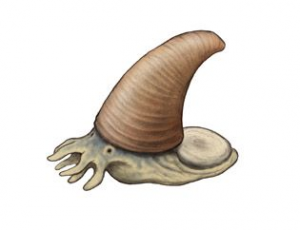
Drawing of Plectronoceras sp. Its shell probably facilitated buoyancy control, a phenomenon also seen in modern nautiloids. Credit: Debbie Snider
Molecular data estimate the divergence time of subclasses that have recent representatives, Nautiloidea and Coleoidea and places it in the mid-Palaeozoic (cca. 440 mya). In contrast to nautiloids, the coleoids diverged substantially in the Permian – 298 to 252 mya (Kroger et al. 2011). Further divergence then occurred throughout the Jurassic (201-145 mya) and Cretaceous (145-66), resulting in the variety of forms present in the ocean today.
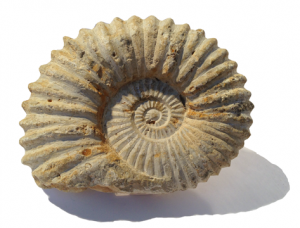
Ammonites, which are more closely related to living coleoids than to nautiloids, are very popular with both amateur and professional palaeontologists. They were wiped out at the Cretaceous Tertiary boundary (cca. 66 mya). Credit: Masur
EXTANT REPRESENTATIVES
The evolutionary relationships in some of the higher and lower taxa are still poorly understood (Albertin et al. 2012; Allcock et al. 2011; Allcock et al. 2014; Allcock 2015; Lindgren et al. 2012; Strugnell et al. 2009). We are herein using the relationships within and among taxa as described by Allcock (2015).
1.) NAUTILOIDEA
Only a few nautiloid species are extant today, although there is no consensus on the number. Nautiloids are considered to be living fossils as their shell morphology has not changed since the late Carboniferous and they display many ancestral traits such as an external chambered shell (Teichert & Matsumoto 2010).
Extant nautiloids are found in two genera Nautilus and Allonautilus. The species found in these genera are distinguished by many characteristics such as differences in gill structure and the male reproductive system (Saunders 1987).
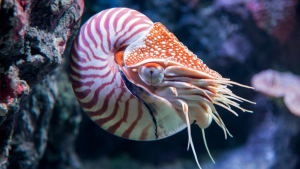 Source: www.monteraybayaquarium.org
Source: www.monteraybayaquarium.org
2.) COLEOIDEA
Unlike its extant sister group Nautiloidea, whose members have a rigid outer shell for protection, the coleoids have at most an internal cuttlebone, gladius or shell that is used for buoyancy or support. Some species have lost their internal skeleton completely (Roper et al. 1984)
The feature that distinguishes decapodiforms from the octopodiforms is the modification of the fourth pair of arms into tentacles.
These can be either long and used as a fishing line or short and muscular. The latter can be for the purposes of feeding quickly extended and then completely retracted (source; TimeTree).
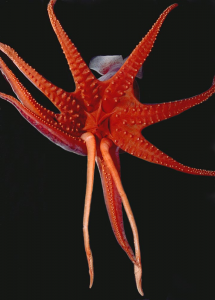 Source: TimeTree
Source: TimeTree
The group contains seven orders (Allcock 2015):
- Sepiida (cuttlefishes)
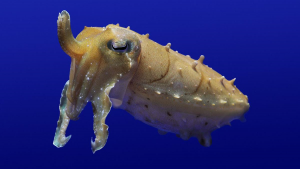 Source: monteraybayaquarium.org
Source: monteraybayaquarium.org - Sepiolida (bobtail and bottle-tail squids)
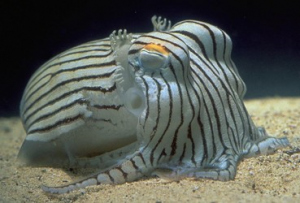 Source: TimeTree
Source: TimeTree - Idiosepiida (pygmy squids)
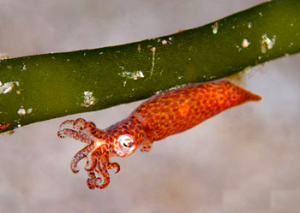 Source: www.blueanimalbio.com
Source: www.blueanimalbio.com - Myopsida (myopsid squids)
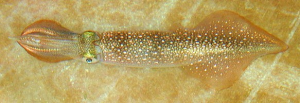 Source: TimeTree
Source: TimeTree - Oegopsida (oegopsid squids)
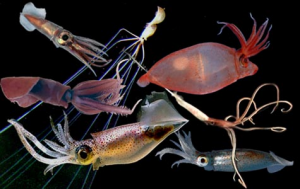 Source: TimeTree
Source: TimeTree - Bathyteuthida (Bathyteuthid squids)
 Source: TimeTree
Source: TimeTree
2.2) Octopodiformes
There are approximately 300 species of Octopodiformes contained within two groups, Octopoda and Vampyromorpha. All but one species is contained in Octopoda, with Vampyromorpha containing just one species Vampyroteuthis infernalis (more commonly known as the vampire squid).
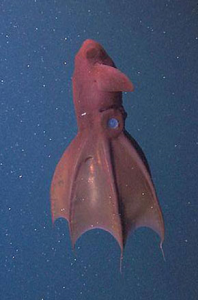 Source: www.morning-earth.org
Source: www.morning-earth.org
Octopoda is then divided into two suborders Cirrata and Incirrata. Cirrata have large fins and are more commonly known as the “finned octopods”. Incirrata contains the benthic octopuses which can be found in shallow waters or the deep-sea and also pelagic species (Source: TimeTree).
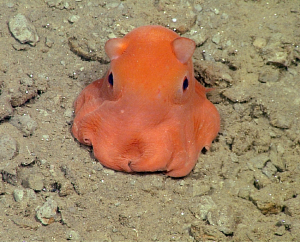 Source: monteraybayaquarium.org
Source: monteraybayaquarium.org
FUN FACTS AKA DID YOU KNOW?
- Cephalopods have been known to climb out of their aquaria, maneuver a distance of the lab floor, enter another aquarium to feed on the crabs, and return to their own aquarium
- Cephalopods are social creatures; when isolated from their own kind, they will sometimes shoal with fish (Packard 1972).
- Although the majority of known cephalopods have an ink sac, which can be used to expel a cloud of dark ink to confuse predators, the deep-sea ones lack that novelty . . . There is no point in using a “smokescreen” if it’s already dark, right?
- Cephalopods are the only molluscs with a closed circulatory system
- Cephalopod blood is colorless when deoxygenated and turns blue when exposed to air
- Nautilus uses its shell to control buoyancy. LINK source: monteraybayaquarium.org
- Cuttlebones are not bones, but rather an internal shell of a cuttlefish. Bird lovers usually present them to their pet parrots.
- Calamari is a culinary name for squid, especially for dishes from the Mediterranean
-
Nautiluses have up to 47 pair of arms. Wow, that is a handful! (Saunders 1987)
-
Vampyroteuthis infernalis means “Vampire Squid from Hell.” Not only is it not a squid (it’s an vampyromorph!), it is very resourceful when it comes to defence. Its arms have a photophore (a light-emitting organ) at the end, and they can be moved in very dramatic ways to confuse a predator (Robison et al. 2003). It can also release bioluminescent mucus from their oral surface, creating a cloud of light around its body that serves as a distraction(Robison et al. 2003).
- Coleoids have two gill hearts and a single systemic heart that pumps the oxygenated blood through the rest of the body.
Created by Morag Taite & Nik Lupše
PAPERS:
Albertin CB, Bonnaud L, Brown CT, Crookes-Goodson WJ, da Fonseca R, Di Cristo C, Dilkes BP, Edsinger-Gonzales E, Freemen RM, Hanlon RT, et al. Cephalopod genomics: a plan of strategies and organization. Stand Genomic Sci. 2012;7:175–88.
Allcock L, A. Lindgren & J. M. Strugnell (2014). The contribution of molecular data to our understanding of cephalopod evolution and systematics: a review, Journal of Natural History
Allcock L. Systematics of Cephalopods (2015). Evolution of Venomous Animals and Their Toxins. Springer Science+Business Media Dordrecht . DOI 10.1007/978-94-007-6727-0_8-1
Kröger B, Vinther J, Fuchs D (2011). Cephalopod origin and evolution: a congruent picture emerging from fossils, development and molecules. Bioessays. ;33:602-13.
Mather, Jennifer A., and Kuba, Michael J (2013). The cephalopod specialties: complex nervous system, learning, and cognition 1.” Canadian Journal of Zoology 91.6: 431-449
Robison, B. H., Reisenbichler, K. R., Hunt, J. C., & Haddock, S. H. 2003. Light production by the arm tips of the deep-sea cephalopod Vampyroteuthis infernalis. The biological bulletin. 205; 102-109